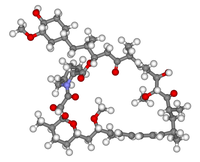
Photo from wikipedia
Our investigation includes the synthesis of new naphthalene-bis-triazole-bis-quinolin-2(1H)-ones 4a–e and 7a–e via Cu-catalyzed [3 + 2] cycloadditions of 4-azidoquinolin-2(1H)-ones 3a–e with 1,5-/or 1,8-bis(prop-2-yn-1-yloxy)naphthalene (2) or (6). All structures of the… Click to show full abstract
Our investigation includes the synthesis of new naphthalene-bis-triazole-bis-quinolin-2(1H)-ones 4a–e and 7a–e via Cu-catalyzed [3 + 2] cycloadditions of 4-azidoquinolin-2(1H)-ones 3a–e with 1,5-/or 1,8-bis(prop-2-yn-1-yloxy)naphthalene (2) or (6). All structures of the obtained products have been confirmed with different spectroscopic analyses. Additionally, a mild and versatile method based on copper-catalyzed [3 + 2] cycloaddition (Meldal–Sharpless reaction) was developed to tether quinolinones to O-atoms of 1,5- or 1,8-dinaphthols. The triazolo linkers could be considered as anti and syn products, which are interesting precursors for functionalized epidermal growth factor receptor (EGFR) inhibitors with potential apoptotic antiproliferative action. The antiproliferative activities of the 4a–e and 7a–e were evaluated. Compounds 4a–e and 7a–e demonstrated strong antiproliferative activity against the four tested cancer cell lines, with mean GI50 ranging from 34 nM to 134 nM compared to the reference erlotinib, which had a GI50 of 33 nM. The most potent derivatives as antiproliferative agents, compounds 4a, 4b, and 7d, were investigated for their efficacy as EGFR inhibitors, with IC50 values ranging from 64 nM to 97 nM. Compounds 4a, 4b, and 7d demonstrated potent apoptotic effects via their effects on caspases 3, 8, 9, Cytochrome C, Bax, and Bcl2. Finally, docking studies show the relevance of the free amino group of the quinoline moiety for antiproliferative action via hydrogen bond formation with essential amino acids.
Journal Title: Molecules
Year Published: 2022
Link to full text (if available)
Share on Social Media: Sign Up to like & get
recommendations!